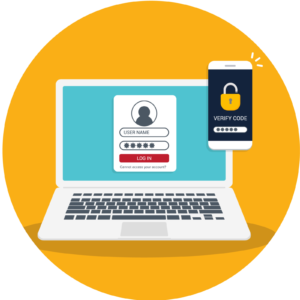In today’s digital age, protecting your online accounts from unauthorized access is more critical than ever. While passwords are still the most common form of securing accounts, they are increasingly vulnerable to cyber threats like hacking, phishing, and data breaches. One of the most effective ways to enhance your security is through Multi-Factor Authentication (MFA).
What is Multi-Factor Authentication (MFA) and Why is it Important?
Multi-Factor Authentication is an enhanced security feature used as part of the login process for digital accounts. Instead of relying on just a password, MFA adds extra layers of protection by requiring one or more forms of verification before you can access an account. MFA makes it much harder for hackers to gain access to your online accounts and sensitive information, even if they have obtained your password.
Here’s why MFA is important to activate:
- Protects Against Password Breaches: Even if a hacker obtains your password through phishing, data breaches, or other means, they will still need this additional factor to gain access. This adds a crucial layer of defense.
- Reduces the Impact of Weak or Reused Passwords: Many people use weak or reused passwords across multiple sites, making them vulnerable to attacks. MFA ensures that even if your password is compromised, an additional verification step is required to access your account.
- Improves Protection of Sensitive Information: For services involving financial transactions, medical records, or personal data, MFA provides an added level of protection. This makes it harder for cybercriminals to steal valuable information or impersonate you.
- Mitigates Phishing and Social Engineering: While phishing attacks are still one of the most common ways accounts are compromised, MFA can thwart them by requiring that the attacker possess something physical (like your phone or biometric data) in addition to your password.
- “Alerts” to Breach Attempts: If a hacker has obtained your user ID and password and attempts to login to your account, a MFA authentication will be triggered. If you receive the MFA notification and are not the one trying to login, this will be your alert that a breach attempt is happening. You can then take immediate steps to thwart further attempts by logging in to change your password and notifying the company, while monitoring future account activity.
How Does MFA Work?
When you attempt to log into an account that uses MFA, you will go through a few simple steps:
- Step One – Password Entry: You start by entering your user ID and password (the first factor) into the login screen.
- Step Two – Additional Verification: Once your password is validated, the system prompts you to verify your identity using another factor. This could be a one-time code sent to your phone or email, a push notification via an authentication app (like Google Authenticator or Microsoft Authenticator), or biometric data if supported by your device.
- Step Three – Access Granted: After successfully completing these steps, you gain access to the account or service.
Types of MFA Methods
There are several MFA methods available, each with varying levels of security and user convenience:
- SMS/Text Message: One of the most common MFA methods, a code is sent via text message to your phone. This is also referred to as One-time Passwords or OTP.
- Authentication Apps: Apps like Google Authenticator, Microsoft Authenticator, and others, generate time-based one-time codes.
- Push Notifications: When you attempt to log in, you receive a notification on your device prompting you to approve or deny the login attempt.
- Biometrics: Fingerprint scanning, facial recognition, or voice recognition offer a highly secure and user-friendly authentication method. These methods are more difficult to spoof and add convenience to the authentication process.
- Hardware Tokens: Physical devices like smart cards provide an additional layer of security. These devices generate a unique code or require proximity to your device to authenticate your login.
How to Get Started with MFA
To set up MFA, check the security settings of your online accounts. Many platforms, such as Google, Facebook, and online banking services, offer easy-to-follow instructions for enabling MFA. Consider using an authentication app for better security and avoid relying solely on SMS-based codes.
Enabling MFA is Added Protection
In a world where cyber threats are becoming more sophisticated, using Multi-Factor Authentication is one of the most simple and effective ways to safeguard your online accounts. MFA is increasingly being adopted across all major online services. Although it might seem like an extra step, you’re taking an essential action toward protecting your personal information, sensitive data, and digital identity.

 CashFlow Connect Business Online Banking Demo
CashFlow Connect Business Online Banking Demo